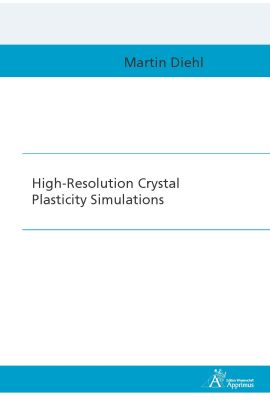In this work the possibilities and capabilities of high-resolution crystal plasticity simulations are presented and discussed. Giving several examples, it is shown how the application of crystal plasticity simulations helps to understand the micro-mechanical behaviour of crystalline materials. To avoid the high computational costs associated with crystal plasticity simulations that arise from (i) the evaluation of the selected constitutive law, and (ii) the solution of the associated mechanical boundary value problem, both contributions to the runtime have to be kept small. This is done by (i) employing a rather simple—and therefore fast—constitutive model, and by (ii) using an effective spectral method employing fast Fourier transforms for solving the partial differential equations describing the mechanical behaviour. Here, an improved spectral solver incorporated into the Düsseldorf Advanced Material Simulation Kit (DAMASK) is used.
Coupled experimental–numerical analyses performed on dual phase steel and magnesium microstructures shows that for highly resolved microstructure discretisations even a comparably simple phenomenological crystal plasticity model is able to predict behaviour in good agreement with experimental observations. Both simulation series complement the experimental investigations to achieve a better understanding of the experimental results.
The influence of the subsurface microstructure on the observed local stress and strain values on a 2D observation plane is investigated with the help of synthetic dual phase steel microstructures and the size of the influenced sub-surface region in dependence on the strain heterogeneity is quantified. A comparison of microstructure generation approaches proves that the use of the fast standard Voronoi tessellation does not introduce a strong bias on the observed stress and strain partitioning in single phase materials at the continuum level. It can be assumed that the standard Voronoi tessellation can also be used without restriction for crystal plasticity simulations. The investigation on strain pattern formation in hexagonal water ice displays the capabilities and limits of the phenomenological material point model in predicting complex patterning phenomena.
| Autor | Diehl, Martin |
|---|---|
| Lieferzeit | 3-4 Tage |
| Gewicht | 0.35 kg |
| Erscheinungsdatum | 02.03.2016 |
Ingenieurwissenschaften
High-Resolution Crystal Plasticity Simulations
Kurzbeschreibung
In this work the possibilities and capabilities of high-resolution crystal plasticity simulations are presented and discussed. Giving several examples, it is shown how the application of crystal plasticity simulations helps to understand the micro-mechanical behaviour of crystalline materials. To avoid the high computational costs associated with crystal plasticity simulations that arise from (i) the evaluation of the selected constitutive law, and (ii) the solution of the associated mechanical boundary value problem, both contributions to the runtime have to be kept small. This is done by (i) employing a rather simple—and therefore fast—constitutive model, and by (ii) using an effective spectral method employing fast Fourier transforms for solving the partial differential equations describing the mechanical behaviour. Here, an improved spectral solver incorporated into the Düsseldorf Advanced Material Simulation Kit (DAMASK) is used.

